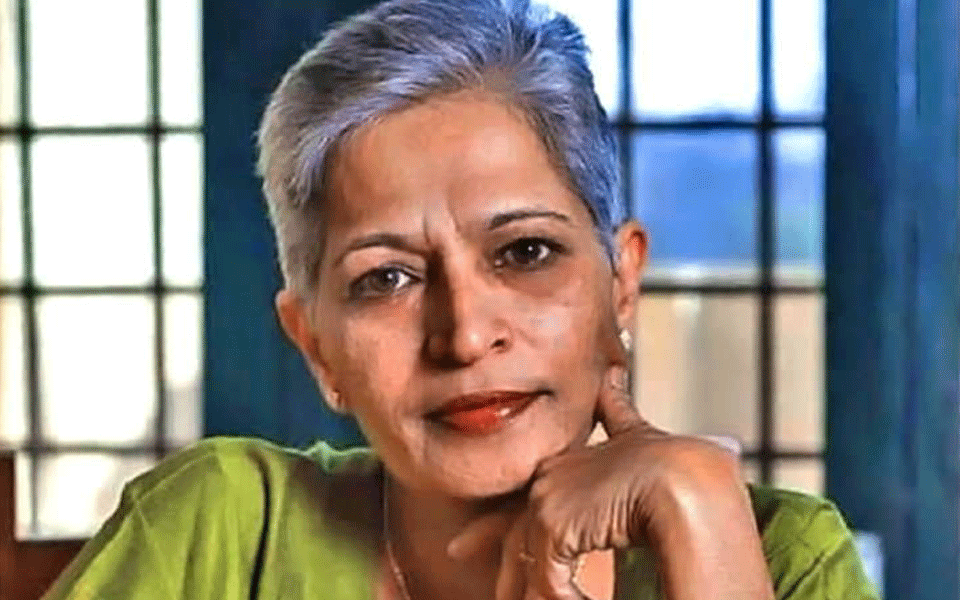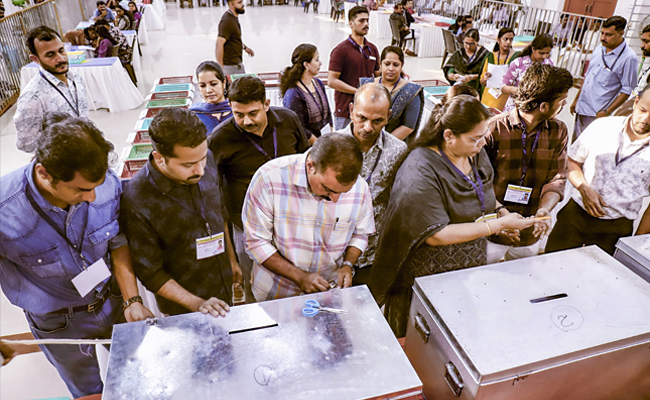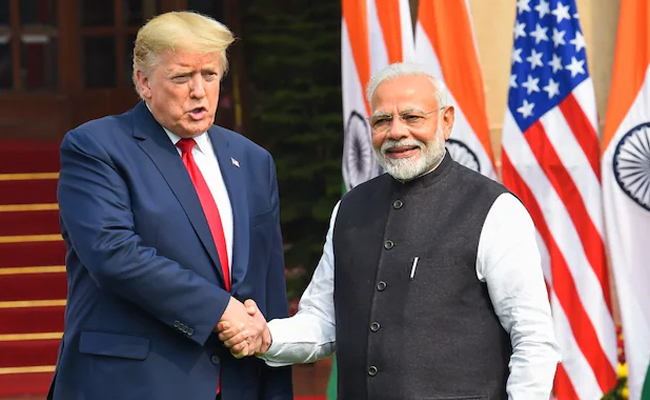Bengaluru, August 29: The idea of creating a 'Hindu Rashtra' led to four activists being murdered by one nameless underground organisation. The organisation has members from Sanatan Sanstha, Hindu Janajagruti Samiti and many other right wing organisations, according to the Special Investigation Team (SIT).
The mastermind of Gauri Lankesh's assassination Amol Kale was a former Hindu Janajagruti Samiti convener and another accused Amit Degwekar was a sadhak in the Sanathan Sanstha.
The nameless underground organisation had a hit list with 26 names across the country and it consisted of 60 people who were planning to execute the assassinations. The SIT shared as many as 14 names on the hit list with Maharashtra Police and Anti-Terrorism Squad (ATS).
The recent arrests of many right-wing members in Mumbai, Maharashtra were based on the information provided by Karnataka SIT. According to the information the detonators and weapons were in possession of members of many right-wing organisations.
UNEARTHING GAURI LANKESH'S MURDER PLOT
The SIT has found that the plan to kill Gauri Lankesh started almost a year before the actual murder took place on September 5, 2017. Amol Kale hired the alleged killer Parashuram Waghmare - a member of Sri Ram Sene.
Waghmare was told to kill Lankesh for the sake of saving Hindu dharam. Kale then took Waghmare to an isolated three-acre land in Khanapur, Belgaum to practice shooting using an air pistol.
Waghmare first came to Bengaluru in July 2017 and did a recce of Gauri's house.
DAY OF THE MURDER
According to the police, Waghmare didn't know any of his associates by name. He only knew them through their aliases. Waghmare was told that someone will pick him up on a bike and he has to pull the trigger of the 7.65 mm country-made pistol.
On September 5 at 8.09 pm, Waghmare arrived on a black motorcycle outside Lankesh's house and assassinated her.
He was accompanied by another man Ganesh Miskin. Ganesh was also carrying a gun, if in case Waghmare failed to hit the target.
Once Gauri Lankesh was shot, Ganesh Miskin and Waghmare rushed towards Mysore Road and met another accused Amit Baddi, who was waiting in a Maruti Omni van. Waghmare and Ganesh Miskin, upon reaching the spot at Mysore Road, handed over the gun, bike, clothes, helmet, and shoes to Amit Baddi.
Both the shooters then headed towards Nelamangala, which is on the outskirts of Bengaluru, to meet another associate Bharat Kurne.
Kurne helped them to board a bus to North Karnataka.
Meanwhile, Amit Baddi took the gun, clothes and the bike to a safe house in Kumbalgodu. The belongings along with the murder weapon were removed from the safe house by Sudhanva Gondhalekar 10 days later. Gondhalekar was recently arrested in Maharashtra.
ROLE OF EACH ACCUSED
Investigating officers feel that the murder was meticulously planned and micro-managed by mastermind Amol Kale. The SIT has arrested 12 people till now in Gauri Lankesh's murder case.
- KT Naveen Kumar - Abettor of the conspiracy; was involved in procuring arms for next assassination
- Sujith Kumar - Recruiter of the murderer (Parashuram Waghmare)
- Amol Kale - Mastermind of the assassination
- Amit Degwekar - Deputy head of the group
- Manohar Edave - Involved in conspiring the murder
- Parashuram Waghmare - The alleged shooter
- Rajesh Bangera - Arms trainer
- Ganesh Maskin - Bike rider
- Amit Baddi - Collected weapon and took it to safe place
- Suresh - House owner where weapon was hidden
- Bharat Kurne - Owner of land where Waghmare practised shooting in 2017
- Mohan Naik - Rented a house for weapon to be kept after the murder
FOUR MURDERS ONE DIARY
When Amol Kale was arrested a few months ago, the SIT found a diary in his possession which had some codes. They cracked the codes and managed to get names and numbers of the other accused in the murder.
When the investigators dug deep into the information in the diary, they realised Amol Kale was also involved in murders of Govind Pansare, Narendra Dabholkar and MM Kalburgi.
Till Kalburgi's murder, Dr Virendra Tawde was heading the nameless organisation, but after his arrest, Amol Kale took over as the head of the group. The information in the diary was shared by the SIT with their counterparts in Maharashtra and many right-wing members were put under surveillance, which resulted in the recent arrests.
WEAPON USED FOR MURDER
Sources in SIT said that the weapon used for Gauri Lankesh's murder and other murders was procured and manufactured by Sharad Kalaskar, who was also arrested by the ATS.
SIT believes that the two guns were used for all four murders.
On the day of the murder, the gang carried two guns. In Pansare's killing both guns were used. In Gauri, Kalburgi, Dabholkar killing, one gun was used, but the second gun was present at the crime scene.
- Said a source from SIT
According to SIT, the weapons seized by ATS in Mumbai consist of these two guns. SIT will now seek the custody of the weapon and send it to forensic laboratory for tests.
HABITUAL OFFENDERS
Amol Kale and gang allegedly threw petrol bombs at a theater in Belgaum during the screening of controversial movie Padmavat. The SIT also unearthed another plot where the same gang had gone to a western music concert in Pune on 2017's New Year's Eve.
The mission was aborted as the gang found CCTV cameras and became alert, and the plan was shelved.
Courtesy: www.indiatoday.in
Let the Truth be known. If you read VB and like VB, please be a VB Supporter and Help us deliver the Truth to one and all.
Thiruvananthapuram (PTI): Buoyed by the strong performance of the Congress-led UDF in the local body polls, KPCC president Sunny Joseph said on Saturday that the front's results indicated the people had rejected the LDF government.
According to early trends, the UDF was leading in more grama panchayats, block panchayats, municipalities and corporations than the LDF.
The local body polls were held in two phases in the state earlier this week.
ALSO READ: Cong candidate who moved Kerala HC for name reinstatement in voter list, wins
Speaking to reporters here, Joseph said the people of Kerala had extended their support to the UDF.
"We could expose the LDF government’s anti-people stance and the people understood it. The LDF’s fake propaganda was rejected by the people. The UDF is moving towards a historic victory," he said.
He said a united effort, proper preparations, good candidate selection and hard work had resulted in the Congress and the UDF’s victory in the elections.
Asked about the prospects in the Thiruvananthapuram Corporation, Joseph said the party was studying the matter and would comment later.
LDF convenor T P Ramakrishnan said the results would be closely examined.
According to him, the government had done everything possible for the people.
"Why such a verdict happened will be examined at the micro level. People’s opinion will be considered and further steps will be taken," he said.
He added that decisions would be taken after analysing the results. "If any corrective measures are required, we will initiate them and move forward," he said.
AICC leader K C Venugopal said the results showed that people had begun ousting those who, he alleged, were responsible for the loss of gold at Lord Ayyappa’s temple.
"This trend will continue in the Assembly elections as well. It is an indication that the people are ready to bring down the LDF government," he said.
Venugopal said the UDF had registered victories even in CPI(M) and LDF strongholds.
"I congratulate all UDF workers for their hard work. Congress workers and leaders worked unitedly," he said.
Referring to remarks made by Chief Minister Pinarayi Vijayan against the Congress on polling day, Venugopal said the voters had responded through the verdict.
"I do not know whether the chief minister understands that the people are against him. Otherwise, he does not know the sentiment of the people. The state government cannot move an inch further," he said.
He said the results indicated a strong comeback for the UDF in Kerala.
Asked whether the Sabarimala gold loss issue had affected the LDF in the local polls, Venugopal said the CM and the CPI(M) state secretary did not take the issue seriously.
"We took a strong stand on the matter. The BJP played a foul game in it," he alleged.
On the BJP's role in the local body elections, Venugopal alleged that the party operated with the CPI(M) 's tacit support.
"The CPI(M) supported the central government on issues such as PM-SHRI, labour codes and corruption in national highway construction. The CPI(M) is facing ideological decline, and the state government’s policies are against the party’s own decisions," he said.
Meanwhile, LDF ally Kerala Congress (M) leader Jose K Mani said the party could not win all the wards it had expected in the elections.
He congratulated winners from all parties and said the party would closely examine the losses and identify shortcomings. "Later, we will take corrective measures," he added.
Senior Congress leader and MP Rajmohan Unnithan said the trends in the local body elections indicated that the UDF would return to power in the 2026 Assembly elections.
"We will win 111 seats as in 1977 and return to power in 2026. The anti-government sentiment of the people is reflected in the elections," he said.
Unnithan said the people were disturbed and unhappy with the present government.
"The trend indicates the end of the LDF government," he added.
CPI(M) MLA M M Mani said the people had shown ingratitude towards the LDF despite benefiting from welfare schemes.
"After receiving all welfare schemes and living comfortably, people voted against us due to some temporary sentiments. Is that not ingratitude," he asked.
Mani said no such welfare initiatives had taken place in Kerala earlier.
"People are receiving pensions and have enough to eat. Even after getting all this, they voted against us. This is what can be called ingratitude," he said.
Muslim League state president Panakkad Sayyid Sadiq Ali Shihab Thangal said the results were beyond expectations.
"The outcome points towards the Secretariat in Thiruvananthapuram, indicating that a change of government is imminent. We are going to win the Assembly election," he said.





